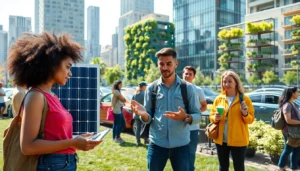Table of Contents
ToggleIn a world grappling with resource scarcity and environmental degradation, the concept of a circular economy is gaining momentum. Unlike the traditional linear model that follows a ‘take-make-dispose’ approach, a circular economy emphasizes sustainability by keeping resources in use for as long as possible. It seeks to minimize waste and promote the continual use of materials, transforming how industries operate and how consumers engage with products.
This innovative model not only addresses pressing environmental challenges but also presents significant economic opportunities. By rethinking production and consumption patterns, businesses can unlock new revenue streams while contributing to a healthier planet. As awareness grows, understanding the principles and benefits of a circular economy becomes crucial for anyone looking to navigate the future of sustainable development.
Overview Of Circular Economy
Circular economy emphasizes sustainability by optimizing resource use and reducing waste. Its principles and importance are crucial for addressing modern environmental and economic challenges.
Definition And Principles
A circular economy refers to an economic framework that encourages the continual use of resources. It contrasts with the traditional linear economy, which follows a ‘take-make-dispose’ model. The main principles include:
- Resource Optimization: Utilizing materials efficiently throughout their life cycles reduces waste and energy usage.
- Waste Minimization: Designing products for longevity and recyclability ensures minimal waste generation.
- Product Lifecycle Management: Focusing on designing, producing, and managing products in ways that extend their lifespan promotes sustainability.
- Closed-Loop Systems: Integrating processes where waste from one product serves as a resource for another enhances efficiency.
Importance In Today’s World
Circular economy’s relevance grows as society faces increasing environmental challenges. Key reasons for its significance include:
- Resource Scarcity: Rising demand for raw materials necessitates sustainable practices.
- Environmental Protection: Reducing waste helps mitigate pollution and climate change effects.
- Economic Resilience: Innovation and new revenue models from circular practices create job opportunities.
- Consumer Awareness: Growing preferences for sustainable products drive businesses to adopt circular strategies.
Understanding and implementing circular economy principles is vital for fostering a sustainable future.
Key Components Of Circular Economy


Key components define a circular economy, focusing on sustainable practices and resource management. Two primary facets are resource efficiency and waste reduction.
Resource Efficiency
Resource efficiency emphasizes maximizing the value derived from raw materials, energy, and water throughout their lifecycle. Implementing strategies such as eco-design and sustainable sourcing promotes optimal use of resources. Utilizing renewable materials enhances sustainability while reducing reliance on finite resources. Companies can achieve resource efficiency by:
- Investing in technology that enhances production processes.
- Adopting sustainable practices in manufacturing and supply chain management.
- Implementing behavioral changes within organizations to promote resource conservation.
These initiatives not only contribute to an efficient economy but also reduce operational costs.
Waste Reduction
Waste reduction involves minimizing waste generation at every stage of production and consumption. Prioritizing strategies like recycling, reusing, and refurbishing prevents materials from becoming waste. Engaging in circular practices can transform waste into resources, fostering a sustainable ecosystem. Key strategies include:
- Designing products for durability and longevity to prolong their lifecycle.
- Implementing take-back schemes to reclaim materials from end-of-life products.
- Employing waste-to-energy technologies to convert unusable waste into energy.
These practices decrease landfill contributions significantly and encourage a shift toward a regenerative economy.
Implementation Strategies
Implementing a circular economy requires strategic planning across various sectors. Two critical components in this endeavor are innovative business models and supportive policy frameworks.
Business Models
Adopting new business models is crucial for transitioning to a circular economy. Examples of effective models include:
- Product-as-a-Service: Companies offer services instead of products, ensuring durability and maintaining ownership of the products. This model encourages recycling and reusing.
- Closed-Loop Supply Chains: Organizations design products for end-of-life disassembly, allowing materials to be reused in new products.
- Take-back Schemes: Businesses establish programs for collecting used products, facilitating their refurbishment or recycling.
These models promote responsible consumption while ensuring resource efficiency, creating economic benefits for both companies and consumers.
Policy Frameworks
Supported by robust policy frameworks, circular economy initiatives thrive. Policies that facilitate this transition include:
- Incentives for Sustainable Practices: Governments provide tax breaks or grants for businesses adopting circular practices, encouraging investment in sustainable technology.
- Regulations on Waste Management: Establishing strict regulations on waste disposal compels organizations to innovate toward waste reduction.
- Promotion of Research and Development: Funding for R&D in circular economy solutions fosters innovation in product design and recycling technologies.
Clearly defined policies guide businesses toward sustainable practices while contributing to overall economic resilience and environmental protection.
Challenges And Barriers
Implementing a circular economy faces significant challenges and barriers. Understanding these complexities helps businesses and policymakers develop effective strategies to overcome obstacles.
Economic Constraints
Economic constraints limit the shift toward a circular economy. Many businesses operate under tight budgets, which can discourage investments in sustainable technologies or practices. Traditional linear models often provide more immediate financial returns. Transitioning to circular models may require upfront capital for infrastructure development or technology upgrades. Additionally, fluctuations in raw material costs can impact the feasibility of circular initiatives. Companies may hesitate to adopt an approach that entails uncertain economic benefits in the short term.
Social Attitudes
Social attitudes also impact the transition to a circular economy. Consumer habits largely favor convenience and immediate satisfaction, which can undermine efforts to promote sustainable practices. Some consumers prioritize low prices over sustainability, making it challenging for businesses to sell eco-friendly products at a higher cost. Moreover, a lack of awareness about the benefits of circular economy principles can result in resistance to change. Educating consumers about the advantages of sustainable choices is crucial for fostering a culture of circularity.
Future Trends In Circular Economy
Emerging trends in the circular economy spotlight innovations and solutions shaping sustainable practices. These trends reflect the evolution of business models, technological advancements, and changing consumer behaviors.
Technological Innovations
Technological advancements play a pivotal role in driving circular economy practices. These innovations enable improved tracking and management of resources, with technologies such as:
- Blockchain: Enhances transparency in supply chains, ensuring traceability of materials.
- IoT devices: Facilitate real-time monitoring and resource optimization in production processes.
- 3D printing: Supports localized production, reducing material waste through on-demand manufacturing.
Increased Collaboration
Collaboration among businesses, governments, and non-profits fosters a stronger circular economy. Partnerships lead to:
- Shared resources: Companies jointly develop sustainable materials or share logistics to minimize waste.
- Collective policies: Governments and organizations work together to create frameworks that support circular practices.
- Knowledge exchange: Information sharing helps businesses adopt best practices and innovative solutions.
Consumer Demand for Sustainability
Changing consumer preferences drive demand for sustainable products and practices. Focus areas include:
- Transparency: Shoppers seek information on product sourcing, lifecycle, and environmental impact.
- Repairability: Consumers prioritize products designed for longevity and ease of repair, opting for brands that support this.
- Circular subscriptions: Subscription models for products, like clothing or electronics, allow consumers to access and return items with minimal waste.
Policy and Regulation Changes
Regulatory shifts influence the implementation of circular economy practices. Key components include:
- Extended Producer Responsibility (EPR): Policies hold producers accountable for the entire lifecycle of their products, promoting recycling and waste reduction.
- Incentives for sustainable innovation: Governments provide grants or tax breaks for businesses adopting circular practices.
- Stricter waste management laws: Regulations encourage reducing waste and transitioning towards closed-loop systems.
Investment in Circular Solutions
Investment trends highlight the financial commitment to the circular economy. Key aspects involve:
- Venture capital: Increased funding for startups focused on sustainable technologies and circular business models.
- Green bonds: Financial instruments supporting projects that enhance environmental sustainability and circular practices.
- Corporate sustainability commitments: Companies investing in circular initiatives demonstrate their commitment to long-term sustainability.
These trends underscore the dynamic nature of the circular economy, fostering innovation and collaboration to promote sustainable practices across industries.







